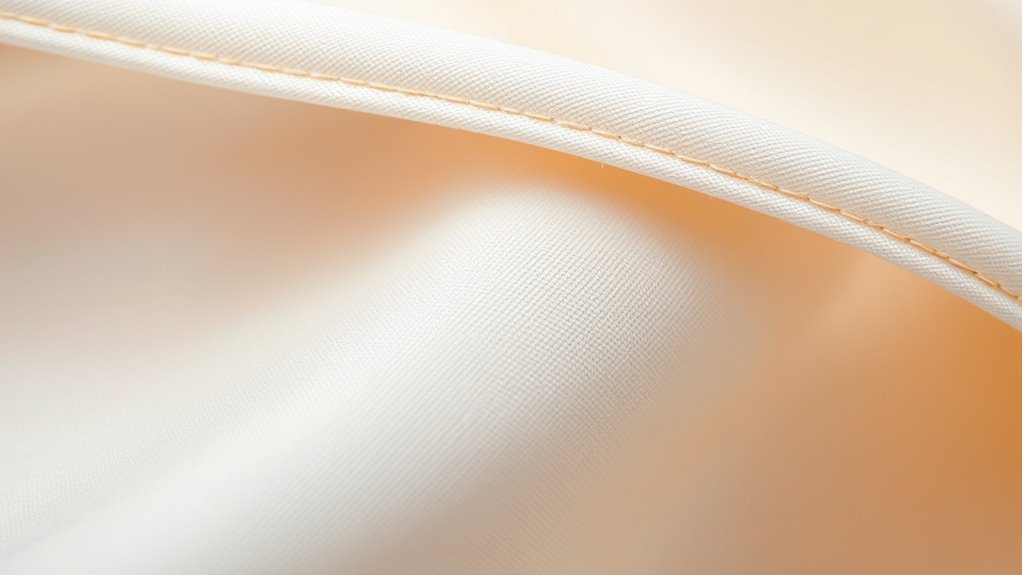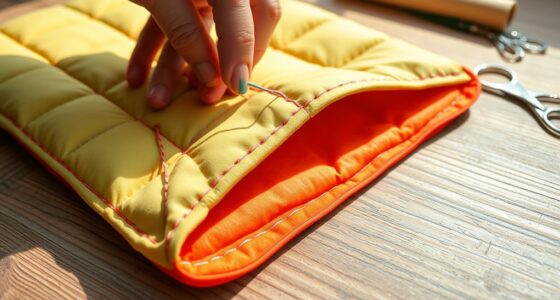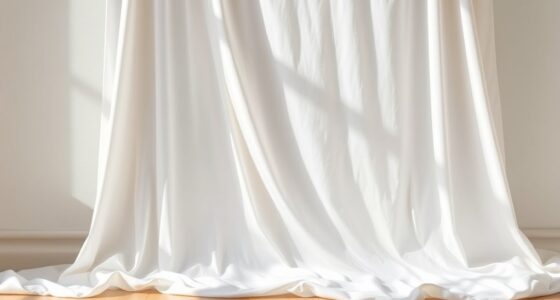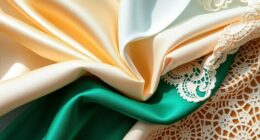To sew French seams for a luxury finish, start with lightweight to medium fabrics like silk or chiffon. Pre-wash and press your fabric, then sew a narrow seam (about 1/4 inch) wrong sides together. Next, press the seam open and fold the fabric so wrong sides are together, enclosing raw edges. Sew a second seam (around 3/8 inch) to hide those edges. Continuing will help you master these steps for a flawless, professional look.
Key Takeaways
- Cut fabric with right sides together and sew a narrow seam (~1/4 inch) to enclose raw edges.
- Press the seam open carefully to set the fabric and ensure precision.
- Fold fabric so wrong sides are together, aligning the seam, then sew a second seam (~3/8 inch) to encase raw edges.
- Press the finished seam flat for a smooth, professional appearance.
- Trim excess fabric and loose threads for a clean, luxurious finish.
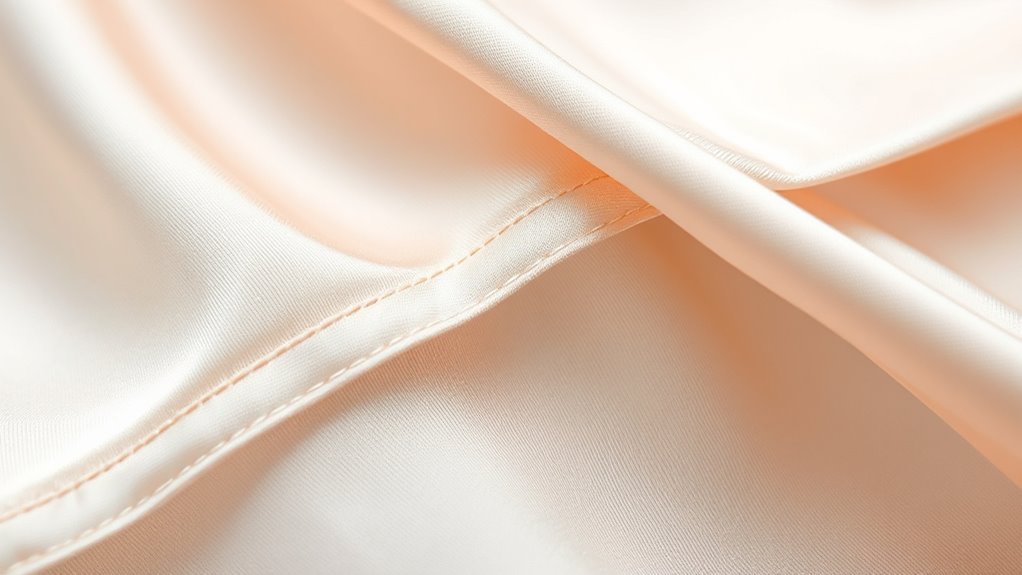
Have you ever wondered how to achieve clean, professional-looking seams that prevent fraying? If so, mastering the art of sewing French seams is a game-changer. These seams create a polished, luxury finish that elevates any project. The key begins with understanding effective sewing techniques and choosing the right fabric selection. Your success depends on both, so pay close attention to the details.
Master French seams for a polished, professional finish that prevents fraying and elevates your sewing projects.
First, selecting the appropriate fabric is essential. French seams work best on lightweight to medium-weight fabrics like silk, chiffon, or fine cotton. These fabrics reveal imperfections easily, so precision is indispensable. Avoid heavier or bulky textiles, which can be difficult to press and manipulate into a neat finish. Once you’ve picked your fabric, pre-wash and press it thoroughly. This step minimizes shrinkage after sewing and guarantees your seams stay crisp.
Next, focus on your sewing techniques. Start by sewing a narrow seam, typically about 1/4 inch, with the wrong sides of the fabric together. This initial stitch encloses the raw edges, preventing fraying. Carefully press this seam open, making sure to set the stitches with an iron. Then, fold the fabric along the seam line so that the wrong sides are together again, enclosing the previous seam. Sew this second seam about 3/8 inch from the edge, encasing the raw edges completely. This double-stitching process results in a clean, durable finish that looks professional.
Pressing is essential throughout the process. Use a hot, dry iron to press each seam flat before and after sewing. Accurate pressing guarantees the fabric lies smoothly, making the seams easier to sew and more precise. When sewing the second seam, keep your stitching straight and consistent. A sewing machine with a fine needle and appropriate tension settings will give you the best results. Take your time to align the fabric carefully, and don’t rush through the steps.
Once finished, trim any excess fabric or loose threads to enhance the clean look. The inside of your garment will reveal a neat, enclosed seam that not only looks elegant but also provides extra durability. Choosing the right fabric and proper technique are crucial for achieving the best results with French seams. French seams are especially suitable for delicate fabrics where a visible, finished edge would be unattractive or prone to fraying. With practice, you’ll find that this technique becomes second nature, allowing you to craft garments with a luxurious, professional finish that stands the test of time.
Frequently Asked Questions
Can French Seams Be Used on All Fabric Types?
French seams work well on lightweight and delicate fabrics, but you shouldn’t use them on heavy or bulky materials, as they can reduce fabric durability and become hard to sew neatly. You’ll want to adjust your sewing machine settings for a clean finish, especially when working with different fabrics. For thicker fabrics, consider other seam finishes that provide more strength, ensuring your project stays durable and professional-looking.
What Tools Are Essential for Sewing French Seams?
Think of sewing French seams like crafting a fine jewelry piece—you need the right tools. Your essential tools include a sharp sewing machine needle, fabric scissors, pins or clips, and a seam ripper for precision. Before you start, make certain your sewing machine is well-maintained for smooth stitches, and pre-treat your fabric to prevent fraying. These tools and preparations make achieving perfect, luxury French seams much easier.
How Do French Seams Affect Fabric Stretch?
French seams can slightly restrict fabric stretch, but they mainly enhance fabric durability and seam reinforcement. As you sew, you’ll notice the finished seam is neat and enclosed, preventing fraying. This technique is ideal for delicate or lightweight fabrics, giving your garment a polished look while protecting the edges. Keep in mind, though, that overly stretchy fabrics might need additional seam techniques to maintain flexibility and comfort.
Are French Seams Suitable for Washable or Dry-Clean-Only Garments?
French seams are suitable for washable garments because they provide excellent fabric durability and seam reinforcement, preventing fraying over time. For dry-clean-only pieces, they also work well, offering a clean, professional finish. However, if your fabric is delicate or prone to damage, consider whether the seam’s bulk might affect the garment’s comfort or appearance. Overall, French seams enhance the longevity and quality of both washable and dry-clean-only clothing.
How Do I Troubleshoot Uneven or Puckered French Seams?
If your french seams are uneven or puckered, start by checking fabric tension and adjusting your sewing machine settings. Too much tension causes seam puckering, so loosen it slightly. Also, make certain you’re using the correct needle and thread for your fabric type. Sewing slowly and evenly helps prevent puckering. Practice on scrap fabric first to perfect your technique, and always press seams carefully for a smooth finish.
Conclusion
Now that you’ve mastered sewing French seams, your projects will have a flawless, professional look. Think about how much more polished your finished pieces will appear with this luxury finish. Are you ready to elevate your sewing skills and add that perfect touch of elegance? Keep practicing, and soon French seams will become second nature—transforming your creations into beautiful, high-end garments or accessories. Happy sewing!
